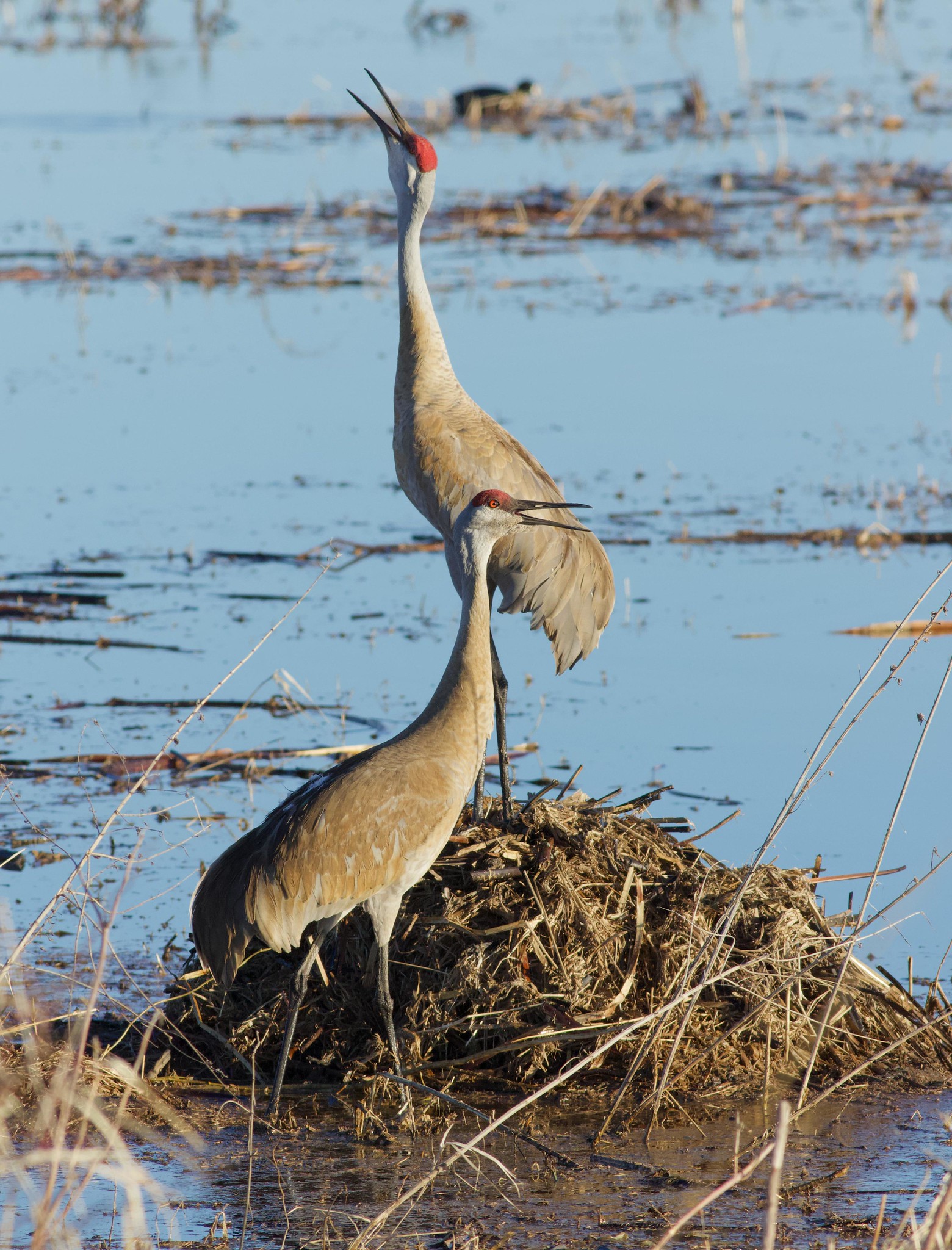Sandhill crane pair in calling in unison at Goose Pond. Photo by Arlene Koziol
One of my favorite birds is the sandhill crane. Their appearance, ecology, resilience, and their signal of spring all appeal to me. They also brought my wife, Sue, and I together. What’s not to love?
Sandhill numbers have had changed dramatically in the past 175 years. Kumlin and Hollister, early ornithologists in southeast Wisconsin, believed that sandhills were an “abundant and common migrant” around the 1850’s.
Sam Robbins wrote in Wisconsin Birdlife (published in 1991) that people thought that crane numbers greatly declined around the early 1900’s due to hunting, and wetland drainage for agricultural development.
In the mid 1930’s the state wide population was estimated at around 25 pairs mostly in west central Wisconsin. Aldo Leopold thought that sandhill cranes would disappear from Wisconsin and penned “A Marshland Elegy” in the 1940’s to mourn that idea.
Students at UW Stevens Point began studying cranes in the 1970’s. Ernie Gluesing conducted an aerial census and estimated the state population at 850 in 1973. He also studied crane territories and reported that territories averaged 339 acres.
In the 1970’s I enjoyed fall visits to the area around Muir Park in Marquette county where several hundred sandhill cranes staged and fed in the surrounding area. The Fish and Wildlife Service acquired the large wetland complex adjacent to Muir Park for the cranes. At that time cranes were still uncommon in Dane and Jefferson counties.
In the mid 1970’s the International Crane Foundation began their annual sandhill crane count that now covers parts of six states.
I fondly remember attending a February 21, 1978 meeting at Piason’s restaurant to discuss the Dane County crane count. My friend Dorothy Haines was there and brought along her friend Sue Foote. I apparently made a memorable impression on Sue when I ordered milk with my pizza. (You might know the rest of that story: we dated, married, immediately moved to Goose Pond Sanctuary to take over as resident managers, and have been there ever since!) Ron Sauey, co-founder of the International Crane Foundation, joined us and later that evening, according to my diary, gave an “excellent talk on Siberian cranes” at the monthly Audubon meeting.
Two sandhill cranes in flight. Photo by Arlene Koziol
Sam Robbins wrote sandhill cranes were that cranes were an uncommon migrant and uncommon summer resident. Sam also mentioned crane researcher found nests with eggs as early as April 22 and that most cranes left Wisconsin in October following the start of the waterfowl hunting season.
Crane numbers and biology have changed much since the 1970’s. The first Breeding Bird Atlas (1990’s) found cranes incubating by March 22. Cranes also nest on small wetlands and appear to have smaller territories. Cranes do not leave Wisconsin when waterfowl hunting season begins. Thousands of cranes stage at Crex Meadows in Burnett County and along the Wisconsin River in Sauk County by the Leopold Shack and Foundation, and do not usually leave until November.
Sandhill crane building a nest at Goose Pond, April 8, 2019. Photo by Arlene Koziol
Crane numbers have also greatly increased in Columbia County. In 1995, Sue and I recorded the first sandhill crane nest at Goose Pond and continue to participated in the annual crane count. This year, I counted at Goose Pond on April 13. I was excited to be up before dawn and wondered what I would find with record amount of water. It did not take long to hear and see cranes and ended up finding three pairs and two individuals. Usually there are a pair of cranes on the west pond and a pair on the east pond.
Goose Pond was alive with birds. I counted 37 species of birds by 7:30 a.m. and ended the day finding five more species. Highlights that day included 16 species of ducks, a flock of 25 white-fronted geese, two horned grebes, large numbers of American coots, and a pair of northern harriers with the male in courtship display. At dusk I was treated to seeing a short-eared owl hunting about 50 yards east of the house.
Sandhill cranes on the nest. Photo by Arlene Koziol
There are two pairs nesting on the west pond with 40 yards of Prairie Lane and Goose Pond Road and probably a pair in the Manthe wetlands on the east pond. Sue and I hope you can visit this summer and enjoy these fascinating birds along with the other wetand and grassland birds.
Written by Mark Martin, Goose Pond Sanctuary resident co-manager








